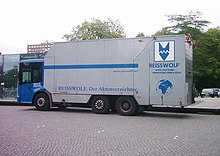Leading axis
In chassis technology, the leading axle is an axle that serves to relieve weight and is positioned in front of the drive axle. Leading axles are usually used in commercial vehicles ( trucks , buses ). In contrast, leading axles have become rare in rail vehicles; they were often used in locomotives with coupled drive wheel sets such as steam locomotives . Here, however, one usually spoke only of wheels or wheel sets and not of leading axles.
Leading axles are used wherever high loads have to be transported and commercial vehicles with two axles ( GVW up to 18 t) are no longer sufficient. As a rule, the leading axle, in contrast to the twin-tyred drive axle, only has single tires and is mostly steered.
A leading axle is required, where there is usually a high load on the rear of the vehicle. This can e.g. B. be skip loader or press garbage truck , the loading process or the pouring shifts the center of gravity of the vehicle to the rear. Occasionally there are also bus models with a leading axle, such as the Van Hool new A330 Fuel Cell .
Semi-trailer tractors in the weight range between 18 and 25 t gross vehicle weight can also be equipped with leading axles. The reason in addition to the shifted center of gravity is also that with a leading axle the wheelbase between the front and rigid drive axle is long enough to ensure a certain driving stability.
In other cases, trailing axles are used. These offer the advantage of a smaller turning circle , since the wheelbase is reduced to the rigid drive axle and a less complex construction of the drive shaft, which does not have to be guided past an axle assembly in front of it. Leading axles can also be designed as lifting axles .
Compared to rigid double axle units such as those used in heavy dump trucks, they offer the advantage of less shearing movement on the tires and road surface and less rolling noise.
